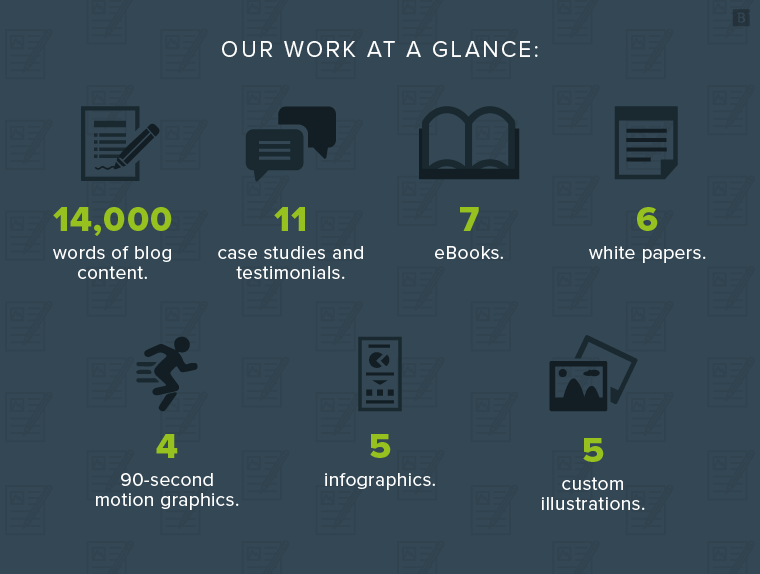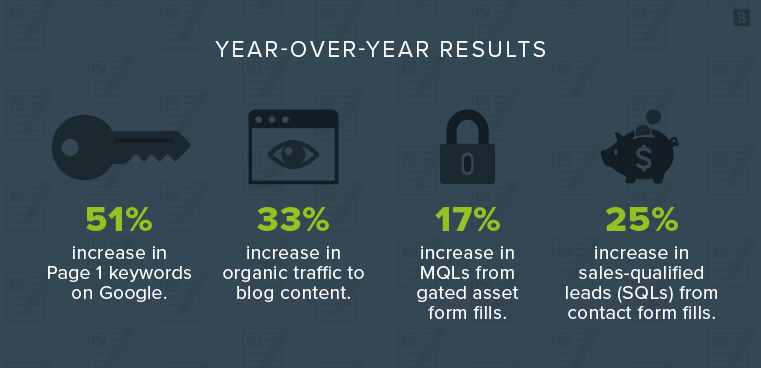It’s a tale as old as time.
One of the largest B2B IT solutions companies in North America needed more leads in the pipeline, and not just a temporary injection, but a sustained lead generation engine.
Enter inbound marketing – the gift that keeps on giving.
When you improve your website’s ranking for targeted, highly relevant keywords, you make your brand more visible to the people searching those keywords for as long as you rank for them.
That means more qualified traffic and more qualified leads over an extended period of time.
Which is exactly what we achieved for our IT solutions client.

Our work at a glance
- 14,000 words of blog content.
- 11 case studies and testimonials.
- 7 eBooks.
- 6 white papers.
- 4 90-second motion graphics.
- 5 infographics.
- 5 custom illustrations.
The mission: More qualified leads, less work
If it exists, someone has searched for it on Google. The key is to figure out what query they’re using to find whatever “it” is.
So in the case of our client – which helps many of its business customers migrate their operations into the cloud – a query like “cloud migration strategy” or “IT resilience controls” would be the type of phrase that they would want to rank for.

Keyword data for “cloud migration strategy” on Ahrefs.
Our mission was to identify those types of keywords and create blog posts that would rank for them to drive traffic from organic search.
And that’s what we did.
In total, we completed about 14,000 words of blog content. We accented those posts with branded custom illustrations that popped a little more than the stock photography they’d been using. Additionally, we created 5 infographics and 4, 90-second how-to videos.
Of course, traffic is not the same as leads. So we also created deeper-funnel, gated assets to help generate marketing-qualified leads (MQLs). The lineup:
- 7 eBooks.
- 6 white papers.
To round out our strategy, we wrote and designed 11 case studies and testimonials to provide leads and prospects with social proof of our client’s bona fides.
The outcome: Exactly what we’d hoped for, no less than we’d expected
Year-over-year, here’s what that looked like:

- 51% increase in Page 1 keywords on Google.
- 33% increase in organic traffic to blog content.
- 17% increase in MQLs from gated asset form fills.
- 25% increase in sales-qualified leads (SQLs) from contact form fills.
Basically, we succeeded in ranking on Page 1 for more keywords, which in turn, drove more traffic to the site. More traffic meant more opportunities for lead generation, which culminated in a YoY increase in both MQLs and SQLs.
The lesson: Data-driven content marketing works
The data part is in the keyword selection, but also in Search Performance Briefs, which instruct writers on how to create a piece of content that will rank for a chosen keyword.
The content marketing element is in using additional on-site content – eBooks, white papers, case studies – to keep new inbound web users engaged.
The best part is that as long as you continue to rank on Page 1 for your keywords, they’ll continue to drive traffic to your site.
And when you drive more traffic, you improve your chances of potentially ranking for other keywords. Not to mention, you keep those lead-generation opportunities rolling in.
Success begets success, and in inbound marketing, success starts with SEO.



